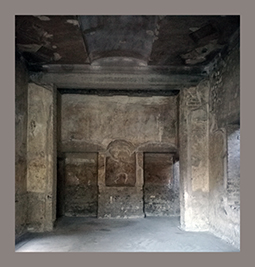Autore: C. Parigi
Scarica l’articolo in formato .pdf: Die Villa A von Oplontis. Neue Forschungen zur Aufstellung und Deutung der Skulpturenausstattung
 The project “Skulpturenausstattung und Architekturdekor der Villen von Oplontis”, funded by the Deutsche Forschungsgemeinschaft and carried out by the Archaeological Institute at the University of Cologne in cooperation with the Parco Archeologico di Pompei, analysed the marble decoration of the Villas at Oplontis, with particular attention on the sculpture and building ornaments of Villa A. The aim of the project was to document the sculptures and building materials scientifically and with high quality photographs, in order to study their placement in the villa, their purpose and their interpretation. The combination of data from the digitized inventory, the excavation diaries as well as the photographs, the high-quality photographic documentation and the precise autopsy of all the marble objects provided the fundamental basis for a critical reassessment of the finds. By adopting a material-orientated approach, it was possible to clarify production technique, regional attribution and date of the sculptures, to prove the multi-phase nature of the statuary furnishing and to clarify the exact positioning of some of the sculptures in the gardens of the villa. The article briefly describes the results of the investigation of the sculptural decoration.
The project “Skulpturenausstattung und Architekturdekor der Villen von Oplontis”, funded by the Deutsche Forschungsgemeinschaft and carried out by the Archaeological Institute at the University of Cologne in cooperation with the Parco Archeologico di Pompei, analysed the marble decoration of the Villas at Oplontis, with particular attention on the sculpture and building ornaments of Villa A. The aim of the project was to document the sculptures and building materials scientifically and with high quality photographs, in order to study their placement in the villa, their purpose and their interpretation. The combination of data from the digitized inventory, the excavation diaries as well as the photographs, the high-quality photographic documentation and the precise autopsy of all the marble objects provided the fundamental basis for a critical reassessment of the finds. By adopting a material-orientated approach, it was possible to clarify production technique, regional attribution and date of the sculptures, to prove the multi-phase nature of the statuary furnishing and to clarify the exact positioning of some of the sculptures in the gardens of the villa. The article briefly describes the results of the investigation of the sculptural decoration.
Das vom Forschungsarchiv für Antike Plastik der Universität zu Köln in Kooperation mit dem Parco Archeologico di Pompei durchgeführte und durch die Deutsche Forschungsgemeinschaft geförderte Projekt „Skulpturenausstattung und Architekturdekor der Villen von Oplontis“ hat sich mit der systematischen Erschließung und Dokumentation der Marmor-Dekoration der Villen A und B von Oplontis befasst, wobei die Skulpturen und die Architekturdekoration der Villa A besonders berücksichtigt wurden. Ziel des Projektes war die wissenschaftliche Erschließung und Dokumentation der Marmorobjekte, um im Anschluss daran Aufstellungskontext, Zweck und Bedeutung der Objekte zu untersuchen. Die Kombination der Daten aus dem digitalisierten Inventar, den Grabungstagebüchern und -fotografien sowie der qualitätvollen Fotodokumentation und der präzisen Autopsie aller Objekte aus Marmor lieferte die grundlegende Basis, um Funde und Befunde kritisch neu zu bewerten. Durch einen materialorientierten Ansatz konnten Herstellungstechnik, regionale Zuordnung und Zeitstellung der Skulpturen geklärt, eine Mehrphasigkeit der Statuenausstattung belegt und die genaue Positionierung einiger Skulpturen in den Gärten der Villa präzisiert werden. Der Aufsatz schildert kurz die Ergebnisse der Untersuchung um die Skulpturenaustattung.
